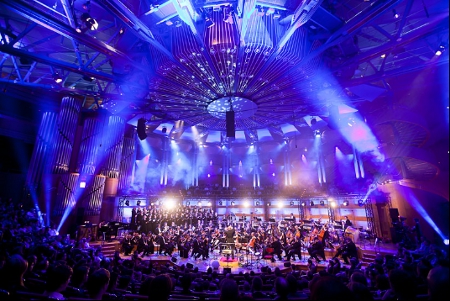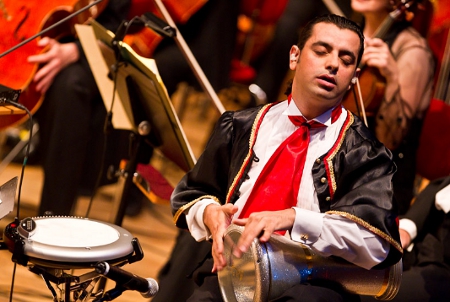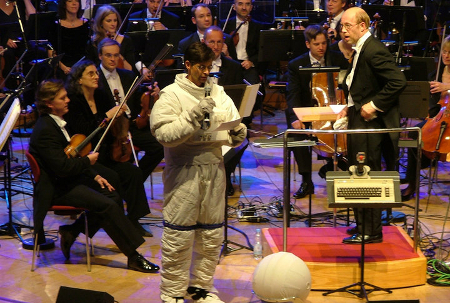Symphonic Legends – Music from Nintendo: Cologne, September 2010 Live Stream
On September 23, 2010, Symphonic Legends celebrated the rich musical history of Nintendo with a special orchestral concert in Germany. The concert was enjoyed by 2,000 people in the beautiful Cologne Philharmonic Hall and tens of thousands also listened across the world through radio and video streams. It was the third in a line of ambitious concerts produced by Thomas Boecker, principally arranged by Jonne Valtonen, and performed by the WDR Radio Orchestra. The organisers intended to provide a successor to their own concerts and Nintendo’s own productions that was both artistically pioneering and popularly pleasing. Combining the concepts of the previous concerts, the first half was dedicated to diverse symphonic suites of favourites from Mario, Metroid, Donkey Kong, and others, much like Symphonic Shades before it. The second half was intended to offer a truly symphonic experience with an encompassing 35 minute tone poem dedicated to The Legend of Zelda.
The concert opened with “Fanfare for the Common 8-Bit Hero”, a contemporary original composition by Jonne Valtonen to represent the personality of Nintendo’s heroes. The opening trumpet and clarinet melodies offer a frivolous and magic quality with a boundless scope. Later passages of the composition transiently capture the feelings of turbulence, contemplation, and triumph with new orchestral colours, yet appropriately it is the lighter tones that predominate; the climax of the composition features a return of the opening melodies in metrically expanded and otherwise humorously distorted form. Under the baton of new principle conductor Niklas Willén, the WDR Radio Orchestra certainly impress here, bringing out all the intricacies and nuances of the score. Following considerable applause, presenter Ralph Erdenberger subsequently appeared on stage to introduce the concept of the concert and offer the first in a series of charming commentaries in German.

Star Fox‘s space suite, contributed by Final Fantasy arranger Shiro Hamaguchi, was the first true arrangement featured on the concert. The suite captures the adventurous spirit of the series with march-like renditions of the interwoven main themes for Star Fox and Star Fox 64. While sophisticated and emotional, the orchestration is considerably more conservative than most would expect from Cologne’s video game concerts and lacks Valtonen’s richness. Thankfully, the chorus is exceptionally expressive throughout the rendition of Corneria’s theme and lifts the suite to new emotional and spiritual dimensions at the climax. In fact, Hamaguchi’s writing is so inspired that it brings back memories of Symphonic Shades‘ X-Out. Though parts of the arrangement are cautious, the suite as a whole serves as an effective introduction to the experience, drawing Nintendo fans in and revealing the momentous timbres to be expected from the rest of the concert.
One of the biggest fan-pleasers of the evening was retro suite dedicated to the Super Mario series. Once again demonstrating his awareness of the fanbase, the producer made an excellent decision to open with an ethereal rendition of “Dire, Dire Docks”, inspiring a huge amount of nostalgia and no doubt some tears among listeners. The scherzo dedicated to Super Mario Bros. 2‘s athletic theme, dark interlude based on Super Mario Bros.‘s underground theme, and, of course, the glorious finale dominated by the series’ main theme are fabulously presented thereafter; arranger Roger Wanamo convincingly combines an emphasis on the simple original motifs with understated yet polished classically-inspired orchestrations. The suite integrates so many tracks into just five minutes that it feels somewhat disjointed, but this is somewhat appropriate given the nature of the original games. In addition, the huge fan applause provides a testament that the item is delightful as a whole too.
Of all the additions to the concert, F-Zero‘s race suite is the least impressive. Returnee Rony Barrak certainly immerses listeners with an abstract extended solo on darbouka and an electric drum. However, Hamaguchi’s orchestration of the “Mute City” and “Big Blue” themes doesn’t quite achieve the same level of dynamism and excitement as their originals, even with the heavy percussion and dissonant flourishes. While still enjoyable, a more spectacular approach was needed to convincingly transform the rock-based originals on to orchestra. Thankfully, the orchestration dedicated to the lesser-known Pikmin made up for this later in the program. After recommending him some years ago, it was fantastic to witness the long-awaited debut of arranger Hayato Matsuo on Boecker’s concerts. He offers a series of variations based on the world map themes, some featuring a simple yet refined dance-like tilt reminiscent of Haydn, others offering a more dramatic romantic textures. They all fluidly come together to form an endearing and intelligent whole.

As expected, modernist composer Torsten Rasch’s interpretation of Metroid has proved the most controversial item on the concerts. The arrangement takes listeners on a dark, terrifying, and futuristic journey with relentless orchestral dissonance and experimental choral chants. Famous themes such as Samus’ and Ridley’s do feature, but they are used to supplement the overall ambience, rather than serving as focal points like other suites. Like his endeavours on the song cycle Mein Herz Brenntpreviously, his galactic warrior suite on Symphonic Legends will leave many Metroid fans confused or even appalled. However, many will consider the deep artistic qualities and intense imagery that this suite offers. Note that Hirokazu Tanaka conceived the dark music for the original Metroid as a rejection of all the clichés and superficialities of other game music of the day. It seems fitting that, several decades later, Rasch does something exactly the same thing with respect to game concerts here. In my opinion at least, it’s an expressionist masterpiece perfectly fitting the Metroid universe.
The most emotional and beautiful moments of the concert were provided by Masashi Hamauzu’s characteristically impressionist interpretation of Donkey Kong Country‘s “Aquatic Ambience”. The composition was written principally for virtuoso pianist Benyamin Nuss, who interprets Hamauzu’s writing in a suitably deep way, though concertmaster Juraj Cizmarovic also features as a standing soloist throughout. The pair harmonise to produce astonishingly beautiful timbres that inspire watery imagery and considerable melancholy. The rest of the orchestra are restrained throughout, offering a series of soft suspended string chords from which the soloists elevate themselves from. However, the track is anything but static and the composition’s more lively segment featuring thick colourful chords and fast-paced piano runs is especially charming. Having seemingly watered down his music after Dirge of Cerberus, it is pleasing that Hamauzu was prepared to be more lavish and creative here. Both modest yet gushing, this is his single most impressive work to date.
The first half of the concert closed with a galactic suite dedicated to Super Mario Galaxy. While the game’s music was written mostly for orchestra, it sounds better than ever in its treatment forSymphonic Legends, given the more elaborate orchestrations and use of a full symphony orchestra rather than a small session orchestra. Arranger Roger Wanamo skilfully combines all the major themes from the game into a single suite that offers a condensed retelling of the game’s story. From its dainty carefree origins representing the Starbit Festival, the suite reminisces about the various tribulations and encounters of Mario with dramatic renditions of the Holst-inspired themes for Bowser’s Fleet, Battle Rock, and King Bowser. A rich performance of Gusty Garden Galaxy by orchestra and chorus closed the nine minute suite to rapturous applause. There was subsequently a twenty minute intermission to allow the audience and orchestra to stretch their legs prior to grand finale. During the intermission, the radio station WDR4 promoted Benyamin Nuss’ debut album with an interview and several beautiful Final Fantasy performances.

The second half of the concert was almost entirely dedicated to Jonne Valtonen’s The Legend of Zelda Symphonic Poem. Inspired by Richard Strauss’ Ein Heldenleben, the poem tells an epic story through music — that of Link’s journey from child to hero. The mythological focus is embellished with Latin lyrics written by an expert transcribe and interpreted by the chorus. In many ways, the poem is structured in a discreet way, featuring five submovements — Hyrulian Child, Dark Lord, Princess of Destiny, Battlefield, and Hero of Time — describing Link’s journey, each featuring distinct famous melodies. However, the poem still offers 36 uninterrupted minutes of music, featuring subtle metamorphoses of mood and beautiful transitions between different melodies. This approach may seem overwhelming to game music listeners used to two minute loops, as its wider inspirations firmly lie in the great romantic symphonists, not Koji Kondo. However, the approach was certainly the correct one from the perspective of both storylining and artistry.
The unprecedented length of the composition was absolutely needed to fully convey the various aspects of the series’ mythology. Following an introduction based on the series’ main theme, Hyrulian Child captures the youth and innocence of Link with another exhibition of feathery yet sophisticated orchestra writing, based mainly on Ocarina of Time’s “Kokiri Forest”. Dark Lord succeeds in offering a chilling and detailed portrayal of Ganondorf, despite the simple nature of his original leitmotif; from its brooding contrabassoon origins, the rendition ascends in both pitch and volume to represent the villain’s sinister ambition, ultimately dominating the poem with a dissonant orchestral and choral tutti. Princess of Destiny thereafter reflects the more mystical component of the series with its ethereal timbres and choral focus, culminating in an unexpected rendition of Twilight Princess’ spirits theme. The simple fact that such contrasting compositions are featured in a single piece is a testament to Valtonen’s ability as a dramatic writer.
The Battlefield portion is the most dramatic part of the poem, given the orchestration is so varied and dynamic. It is especially fitting how each of the solo instruments featured elsewhere in the concert successively take centre stage — percussionist Rony Barrak bringing thrust to “Dark World”, the orchestra’s pianist offering a romantic segue, and violinist Juraj Cizmarovic stunning with his rich timbres once more. It takes the concert round full circle. The poem ends with a decisive recapitulation of the main theme that demonstrates Link’s heroism and triumph in full force. With this climax especially, Valtonen proves that this item is not a merely medley and — as delightful as the featured melodies and their mature orchestrations are — its overall offerings are greater than the sum of its parts and actually tell a meaningful rounded story. Much like Valtonen’s offerings to Symphonic Fantasies previously, the poem is actually never laborous and the half hour flies by while fully satisfying. This is a sign of a great symphony, as are the five minutes of standing ovations that followed it.

Fans were given a surprise encore or, as the presenter described it, a ‘bonus level’ to conclude the concert. The organisers of the concert have apparently named this one the ‘puzzle suite’, presumably because it integrates fragments of so many different pieces in such mind-boggling ways. The focus is initially placed on The Legend of Zelda: The Wind Waker‘s title theme, which brings a significantly different texture to the concert with its folksy fiddle lead. However, Roger Wanamo takes listeners by surprise by harmonising the theme with a choral rendition of Metroid Prime 3: Corruption‘s ending theme, which eventually becomes the focus. The composition grows increasingly complex, as different fragments of Nintendo melodies feature — some taking central stage, others being used in counterpoint, others hiding completely in the background — ultimately uniting themes from franchises like Zelda, Mario, and Star Fox into one. The track ends with a final orchestra crescendo and the choir singing that three syllable word known to all gamers: ‘Nintendo’.
The team of Symphonic Legends have once again succeeded in producing a concert that is both artistically impressive and highly accessible. The treatment of the source material is highly fitting — placing suitable emphasis on the original melodies, fitting the concepts and images of the sourced games, and capturing the overall light and youthful quality of Nintendo. However, the talented arrangers and performers ensure that the often simplistic or superficial nature of Nintendo’s melodies are in no way detrimental to the greater artistic experience. The concert offers everything from gushing and epic orchestrations, to clever melodic and harmonic treatments, to impressionist and expressionist masterpieces, to even a full-length symphonic poem, highlighting every section of the orchestra and several soloists along the way. Admittedly, there are some minor disappointments in terms of selections and arrangements, but these do not detract from the concert’s overall legacy. Currently, no announcements have been made regarding an album release, no doubt complicated by Nintendo’s corporate policies, though the organisers have promised it will be possible to revisit the concert experience in some form.
Do you agree with the review and score? Let us know in the comments below!
5
Posted on September 23, 2010 by Chris Greening. Last modified on March 1, 2014.













